|
Unfortunately, further ongoing and
long-term difficulties still had to be overcome, such as
backlogs of maintenance of all kinds, severe shortages
of coal, staff, and other resources. This long period of
slow recovery did little to assist, as some degree of
material decline had already started to become apparent
at Stafford Road shed. By 1946 its allocation had been
reduced to 74 locomotives, which continued to decrease,
but there were still 99 locomotives allocated over at
Oxley. Table One below offers an overview of the
changing allocation at the shed from the last summer of
the Great Western Railway, in 1947, through to May 1962.
By then the home fleet had been reduced by a third and
just nine classes were represented by the 47 locomotives
on the books.
To compound these difficult times,
the long and bitter winter of 1947 was not far off, and
this brought Britain's railways to a virtual standstill.
The old wartime anti-glare canvas sheets were soon
brought out of the shed storage lockers and pressed into
service to provide some degree of protection on the
footplate from the freezing weather. Ultimately,
following the election of the new Labour Government,
nationalisation of the 'Big Four' companies became
unavoidable, and a new era dawned at Stafford Road depot
from 1 January 1948.
By April of that year British
Railways adopted a new motive power and shedcode
numbering system, and as a consequence Stafford Road was
now designated 84A and Oxley depot was 84B, having
previously been identified as SRD and OXY in GWR days.
Otherwise, very little appeared to change for some
years, apart from the words BRITISH RAILWAYS starting to
appear on the sides of tank engines and on locomotive
tenders.
In August 1950 the number of
engines allocated to Stafford Road depot was down to 66,
and by the mid-1950s building maintenance had also
become of less importance, with roof and gable-end
repairs to the old lower yard broad gauge shed, and the
adjacent 'Arcade' being fitted with pieces of
corrugated-iron sheeting, large sections of which had
rusted through and fallen off by the early 1960s. |
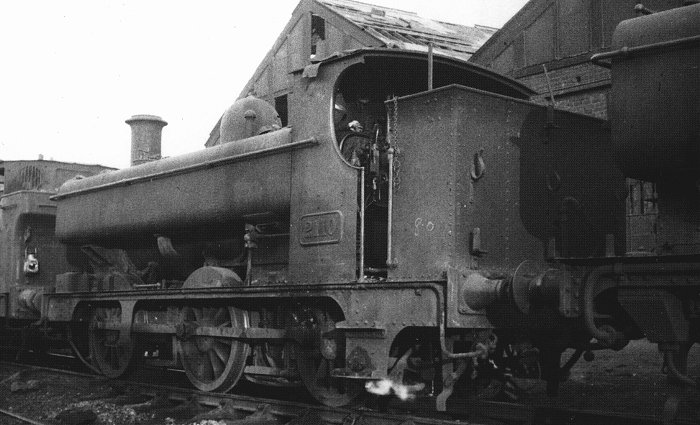
Wolverhampton Works-built 0-6-0PT
No 2110 is at rest on its home shed of Stafford Road in
1947. This '2101' class engine was built in 1902/03 as a
saddle tank with a domeless boiler, notably as one of
the last inside-cylinder GWR 0-6-0Ts to be constructed
for many years. This class harks back to the '850' class
and more recently the '2021', an extended version of the
former to accommodate a larger firebox, while the
'2101s' were built with Belpaire fireboxes. It was the
provision of Belpaire fireboxes for the '2021s' that saw
their widespread conversion as pannier tanks from the
early Churchward years, and No 2110 was clearly
converted too. It would serve until July 1950, being one
of the early withdrawals - some remained on the British
Railways books until 1958, as the last surviving
pre-Grouping 0-6-0 tank engines in service. |
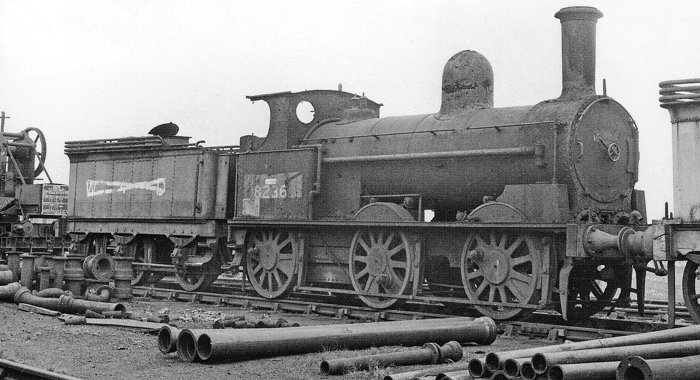
A transient visitor to Stafford
Road shed on 4 September 1949 is former War Department
0-6-0 No 8236, an ex-L&NWR Webb '17in coal engine' or
'Cauliflower Goods'. This was one of three such engines
that had a stopover at Wolverhampton on route to Swindon
Works for scrapping. British Railways acquired these
engines in 1949 having latterly been in use by the War
Department to serve the Central Ammunition Depot at
Nesscliffe on the Shropshire & Montgomeryshire line.
This particular engine emerged from Crewe Works as L&NWR
No 2422 in June 1881, and it was withdrawn from LMS
stock and sold to the Shropshire & Montgomeryshire
Railway in July 1932, passing to the WD in 1941; it was
scrapped in July 1950. Author's Collection. |
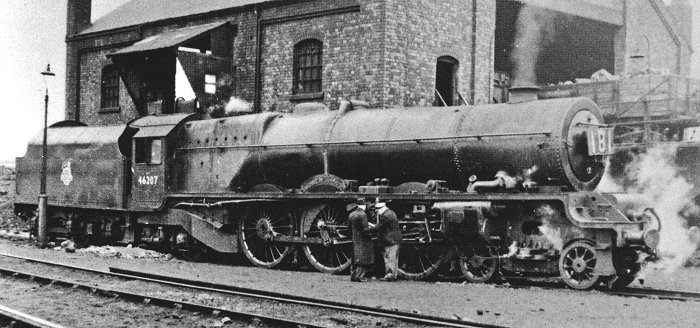
Former LMS 'Princess Royal'
Pacific No 46207 Princess Arthur of Connaught stands
alongside Stafford Road shed's coaling plant during
February 1956. This was one of four ex-LMS Stanier
'Princess Royal' and 'Coronation' Pacifics brought in to
work the London expresses when the 'King' class
locomotives were temporarily withdrawn for repair, due
to cracking to their bogies and frames. Author's
Collection. |
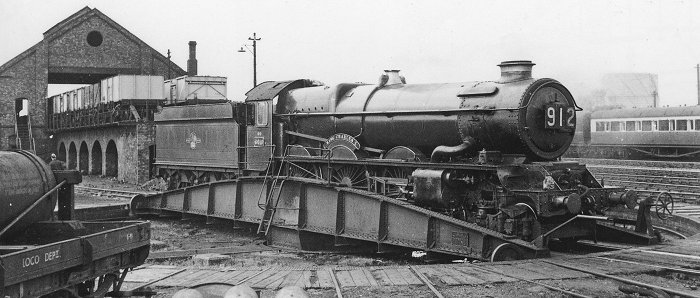
Fitted with a double-chimney in
March 1956, 'King' class No 6010 King Charles I is on
the turntable near the Stafford Road coaling plant on 18
October 1959. The view is taken looking north, the
distant coaches being stabled beside the Shrewsbury
line. Note the empty coal wagons moved to the rear of
the inclined approach into the main coaling stage
building; the coaling process and movement of the
turntable were carried out manually. New to traffic in
April 1928 at Plymouth's Laira shed, King Charles I
served until June 1962, its final allocation being
Cardiff (Canton). Author's Collection. |
|
As with the vast majority of
steam locomotive depots, the threat of closure
appeared on the horizon in January 1955 when British
Railways published a 'Modernisation Plan' with a
view to bringing in diesel and electric traction to
replace steam as soon as possible, but few realised
that the end would come at Wolverhampton in less
than six years. In the meantime, steam power
remained the dominant force, and from April 1959 the
Collett 'King' class 4-6-0s were even allowed to
work onwards from Wolverhampton as far as
Shrewsbury, with a few immaculate engines still
being seen on those workings. However, the
infrastructure back at Stafford Road shed was
continuing to fall into disrepair, and likewise the
working environment there was now becoming somewhat
dirty and unkempt.
Across the country,
increasingly large numbers of steam locomotives were
now being withdrawn for scrapping every month.
However, as from the beginning of 1960 the stage was
set for an Indian summer of steam services from
Wolverhampton (Low Level), followed rapidly by a
period of change and decay. An early warning of
things to come as a result of the 'Modernisation
Plan' was the decision to electrify the West Coast
main line. Due to the disruption being caused
between London (Euston) and Birmingham (New Street)
while this work was carried out, the frequency of
services from Paddington to the Midlands was
increased to help compensate. By early 1962, in
order to cope with the extra trains, no less than 12
'King' class locomotives were now allocated to
Stafford Road shed, instead of the usual stock of
five or six.
Back in September 1960 the
Western Region had also acquired its prestigious
blue and white liveried Metropolitan-Cammell-built
Pullman trains, one of which was used to operate
weekday services from Wolverhampton (Low Level) to
London (Paddington). When not in use, this
'Birmingham Pullman' stock was stabled at Cannock
Road sidings for servicing, only a short walk away
from the old order at Stafford Road shed, providing
clear evidence of things to come. Nonetheless, at
the start of 1962 the Western Region 'Kings' and
'Castles' continued to provide the mainstay of
motive power for express services between
Paddington, Birmingham, and Wolverhampton.
Local goods trains, suburban
passenger and secondary expresses also continued to
be steam-hauled, although diesel-multiple-units and
diesel shunters, and a large number of former LMS
main line steam engines of all sorts, had also
started to make inroads into what had, up until now,
remained an old Great Western-style landscape. In
addition, British Railways Standard class
locomotives, both large and small, were now becoming
a regular sight at Stafford Road and Oxley sheds,
with BR 'Britannia' Pacifics and '9F' 2-10-0s soon
becoming common visitors.
Sadly the Indian summer turned
out to be of a short duration and the next few
months would usher in a vast and irreversible
change. Construction of diesel locomotives had
continued apace, and by May 1962 the first examples
of the new diesel-hydraulic 'Western' class
locomotives had arrived at Oxley, sometimes
supplemented by 'Warships' in preference to Stafford
Road shed, which was by now becoming very run-down
and badly maintained. |
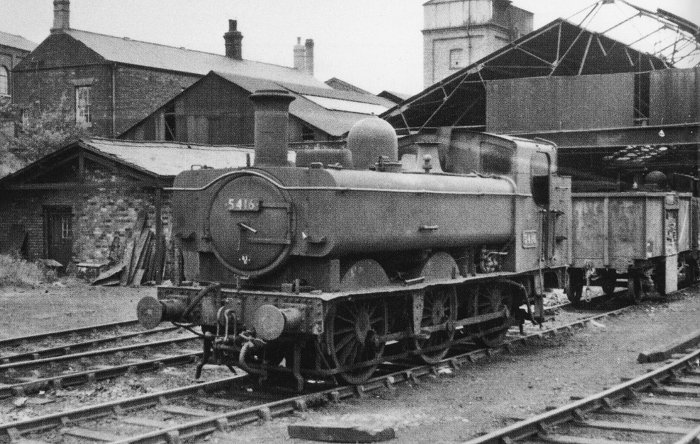
An early 1960s view looking north
records former GWR '5400' class 0-6-0PT No 5416 outside
the entrance to a derelict-looking No 1 shed, Stafford
Road's last active roundhouse. The building to the upper
left was the old GWR Mechanics Institute fronting the
main Stafford Road itself, which assists in locating
this less common viewpoint within the Stafford Road
complex. The longer building seen just to the right of
the Institute was used as the works drawing office. Most
of the 25 '5400' class engines were withdrawn by 1960,
as victims of the dieselisation of passenger services.
No 5416's career began at Southall shed in June 1932 and
concluded at Yeovil Town in August 1963. Author's
Collection. |
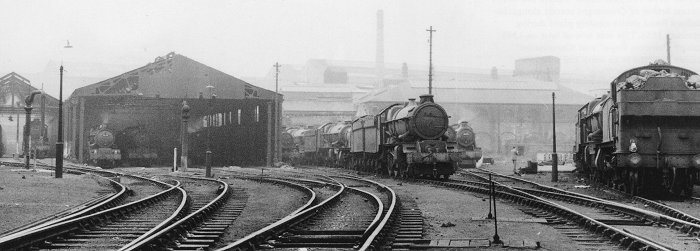
A general view of Stafford Road
shed yard on 21 October 1962 records the sorry state of
much of the infrastructure, with many of the patched-up
building repairs using corrugated iron sheeting falling
away. The two-road 'Arcade', or No 5 shed, is to the far
left, the 1870s extension to the four-road broad gauge
shed is next, and the buildings beyond the mothballed
'King' had seen use as the lifting shop and erecting
shop. Author's Collection. |
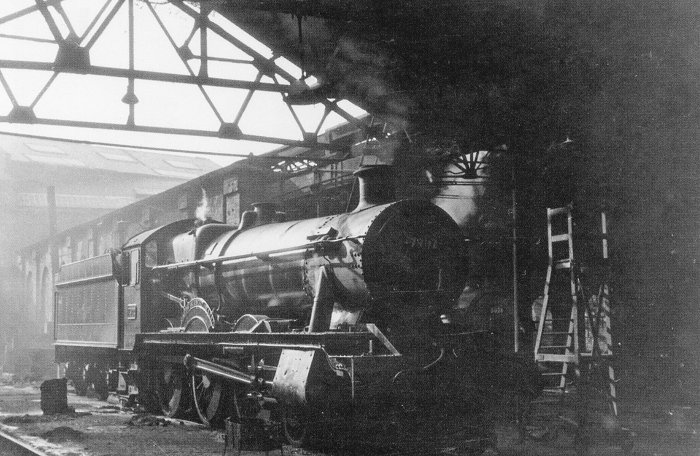
During the summer of 1962,
Stafford Road allocated, Hawksworth-designed and
BR-built 'Modified Hall' No 7902 Eaton Mascot Hall is
stabled just inside the 'Arcade', shed No 5. The scene
provides a rare three-quarter view of the adjoining
1857-built brick building that started out as a broad
gauge locomotive shed, became a tender shop, and then
standard gauge running shed No 4. The original building
only extended as far as the corner support pillar seen
above No 7902's firebox, but the 1870s saw the shed
extended forwards to over double its original length
after its conversion for use as a tender shop, this
extension was by way of timber-covered framework as
opposed to extending the actual brickwork. Simon Dewey. |
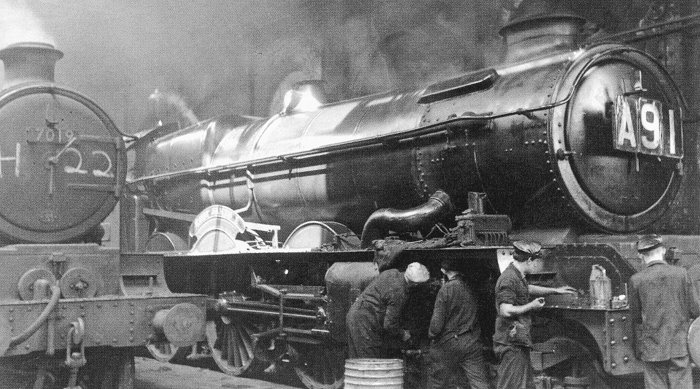
No 6011 King James I is the subject to some discussion
among the shed staff prior to working the 3.35pm
Wolverhampton (Low Level) to Paddington express in the
summer of 1962. Due to the general lack of space at the
shed, light repair work and maintenance was even carried
out in the shed yard, a tradition that was evident when
removal of the 'King' class bogies was required during
1956 in order to rectify fatigue cracks by way of adding
stiffening strips to the bogie frames. Positioned
alongside the 'King' is No 7019 Fowey Castle, which
bears the head code 'H22', chalked on to the smoke box
door; this relates to the 2.05pm Saturdays only
Kingswear to Wolverhampton (Low Level) service. King
James I was for much of the 1950s a Stafford Road asset
and was ultimately credited with 1,718,295 miles when
withdrawn from traffic in December 1962. Simon Dewey. |
|
Although occasional Oxley-allocated
350hp 0-6-0 diesel shunters could sometimes be seen on
site, the only main line diesel ever to be officially
allocated to Stafford Road shed was the white-painted
Birmingham Railway Carriage & Wagon Works Type 4
diesel-electric test locomotive No D0260 Lion. It is
debatable as to whether it ever ventured across the
canal bridge into the actual shed yard, and more than
likely it was simply turned at the coaling plant in
order to maintain the forward position of the 'A' -end
cab, and possibly fuelled at Cannock Road sidings during
its brief spell of work on the Western Region's
Paddington to Birkenhead trains.
During the course of 1962 an
executive decision was taken to affect a complete
wholesale withdrawal of the 'King' class locomotives, to
be replaced by the 'Western' diesel-hydraulics on the
expresses to and from Paddington, and by the autumn of
that year they had all been taken out of service. On 5
November 1962 'Kings' Nos 6001 King Edward VII, 6002
King William IV, 6007 King William Ill, 6012 King Edward
VI, 6014 King Henry VII, 6015 King Richard Ill, 6017
King Edward IV and 6022 King Edward III were noted in
store at Stafford Road shed, awaiting removal for
disposal.
The severe winter of 1962/63
brought widespread disruption, which carried on well
into March and, perhaps as a result, it was autumn 1963
before the last two derelict 'King' and 'Hall' class
locomotives were hauled out of their hiding place in
Stafford Road yard and sent off on their final journeys
to Cox & Dank's at Oldbury and Cashmore's at Great
Bridge, Tipton, for scrapping.
Earlier on, during the latter part
of 1962 it was announced by British Railways that
various regional boundaries were to be re-drawn, and as
from 1 January 1963 the Paddington-Birmingham-Shrewsbury
main line came under the jurisdiction of the London
Midland Region north of Banbury. The new management very
soon arranged for the closure of Stafford Road shed,
effective from 9 September 1963, bringing over a century
of local railway tradition to an end. The remaining
reduced compliment of steam locomotives and footplate
crews were then re-located to Oxley depot, which in turn
would only last until 4 March 1967. Some employees saw
this as an opportunity to either retire or seek
alternative employment in other industries in the town.
In the interim, Stafford Road locomotive works had also
closed down, on 1 June 1964, with former GWR 2-8-0 No
2859 being the last engine to be overhauled and
out-shopped, on 11 February that year. |
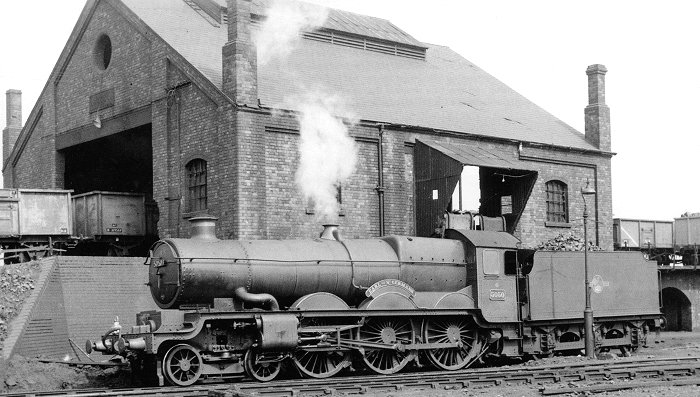
Former GWR 'Castle' class 4-6-0 No 5050 Earl of St.
Germans is seen, circa 1962, alongside the coaling
plant at Stafford Road shed, the coaling process
recently completed. Named Devizes Castle from its
completion in May 1936 through to August 1937, this
Collett engine would be withdrawn from service in
August 1963 from St. Phillips Marsh shed in Bristol.
Earl of St. Germans, in the county of Cornwall, is a
title in the peerage of the United Kingdom that
dates back to 1815. The site of the coaling stage
and oil-gas plant would be demolished a few years
after the closure of Stafford Road shed in September
1963, although the final remains would not be buried
until the late 1980s, when the area was landscaped
as a local park. J. B. Bucknall. |
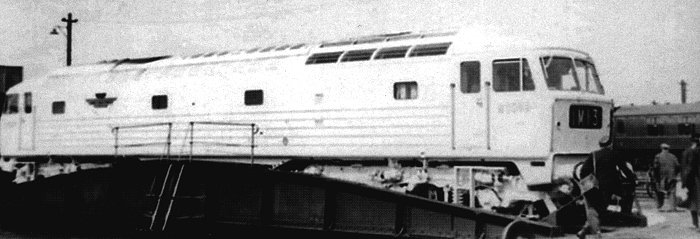
The only main line diesel
to be allocated to Stafford Road shed was No
D0260 Lion. In this scene, Lion, a Type 4 diesel
electric test locomotive built in 1962 by the
BRC&W Co at its Smethwick Works in Birmingham,
is positioned on the turntable at the coaling
plant on 14 May 1962. It had previously worked
the 12.10pm Paddington to Birkenhead service
(1M13) as far as Wolverhampton (Low Level)
station during its first day of revenue-earning
service on the Western Region. It is being
turned so that it can be driven from the 'A' end
cab on its return to Paddington, ensuring that
the white painted buffers remain clean, for
publicity purposes during its inaugural
workings. Soon transferred away to the Eastern
Region for further evaluation, Lion would be
withdrawn from service in about February 1964,
being cut up sometime in 1965 at T. W. Ward's
yard in Sheffield, after being stripped of major
components. Ned Williams Collection. |
|
Previously, back in
July 1959 the British Transport Commission
announced plans to set up of a diesel repair
works at Stafford Road, and this was
reinforced by further positive comments in
1962. However, nothing was to come of this
and even had this proposal actually
materialised it is very unlikely that the
old steam shed and running yard areas would
have been included in the new scheme. With
this in mind, it is interesting to note that
the old 84A Stafford Road shed code went on
to be applied to many diesels as from
January 1963 it was transferred south-west
to Plymouth (Laira) diesel depot, which was
selected in 1961 as the Western Region's
first main line diesel maintenance depot.
Although a purchaser
was soon found for the 10½ acre works site,
it was a long time before clearance and
redevelopment work was finalised in that
respect. Likewise, with the shed and yard
site, where the remains of the lower yard
erecting shop were photographed some twelve
years later, in February 1975, it was still
awaiting final demolition, although the shed
had been demolished by then. Nowadays there
is scant remaining evidence available to
pin-point the exact location of Stafford
Road shed other than the survival of the
blue-brick wall that ran alongside the edge
of the shed yard at the rear of the now
long-gone Dunstall Park station.
As is so often the case
these days with redevelopments, both the
shed and works areas at Stafford Road are
now used by light industrial and trade
outlet units. The dual twin-bridge sections
across the BCN canal, of which one half had
provided the entrance into the shed yard,
are still in existence at the time of
writing, but that section is now blocked
with rubble, is overgrown and fenced off.
The historical
importance of those few architectural and
industrial remains still found alongside the
canal close to what used to be the site of
the Stafford Road shed has recently been
noted by the local council. Hopefully such
evidence as still exists will now continue
to be preserved and signposted as best as
possible within the scope of the
Wolverhampton Locks Conservation Area.
John Bucknall and Simon
Dewey must both be given due credit for
their invaluable assistance and photographic
input in connection with this article. The
contribution to early railway history at
Wolverhampton, as can be derived from the
photographs taken at Stafford Road by R. H.
and R. E. Bleasdale, must also be taken into
account as many of the photographs that are
reproduced here have been taken from some of
their original sepia prints. Thanks also go
to Colin Moss with regard to his help
regarding diesel workings in the
Wolverhampton area in the 1960s. Finally, my
thanks go to Mrs E. B. Jeff for her
permission to quote and use material from
the publications by her grandfather, Harold
Holcroft.
References
The Armstrongs of The
Great Western - Harold Holcroft.
Locomotive Adventure - Harold Holcroft.
An oudine of Great Western Practice and
Performance 1837 to 1947 - Harold Holcroft.
The Wolverhampton Railway Gazette -
published by John Bates and Mervyn
Srodzinsky.
Rail Centres: Wolverhampton - Paul Collins.
Brunel's Broad Gauge in the Black Country -
Michael Hale.
The Locomotives of The Great Western Railway
- published by The RCTS.
The Wolverhampton Chronicle and Express &
Star newspapers. |
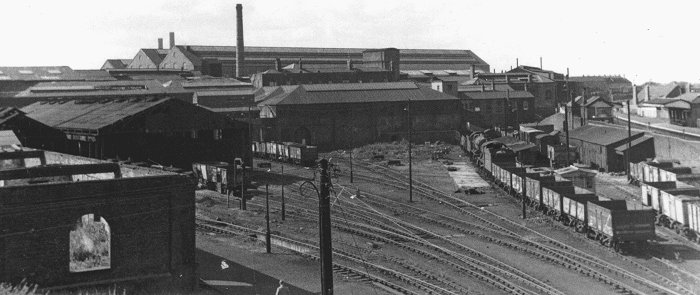
Stafford Road shed
yard on the eve of closure, Saturday, 7
September 1963. The last two locomotives
awaiting removal are 'King' class 4-6-0
No 6012 King Edward VI and No 5910 Park
Hall. Both are allocated to Stafford
Road shed, the closure of their home
depot ended their careers. The 'King'
would be scrapped at the hands of Cox &
Danks of Oldbury, with the demise of
Park Hall undertaken by Cashmore of
Great Bridge. Viewed from the elevated
position of the Stour Valley viaduct,
the line to Shrewsbury can be seen
passing through Dunstall Park station,
to the right. The shed yard could easily
be viewed by looking over the wall
running alongside the rear of the down
platform. On the far left is roundhouse
No 3, and beyond the roofs of the
'Arcade', shed No 4 and the lifting and
erecting shops is the dominant outline
of Stafford Road Works, which would
close in February 1964. This view makes
a very interesting comparison to the
1883 scene shown below. Simon Dewey. |
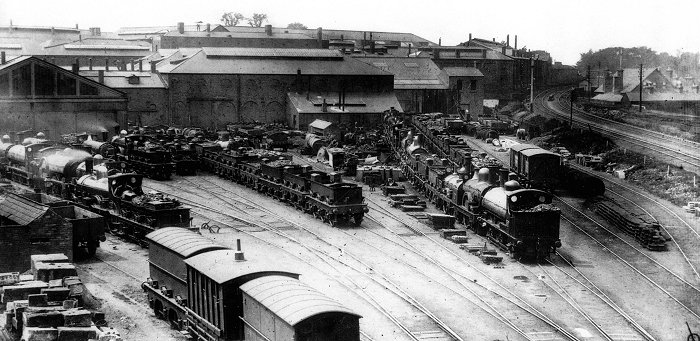
Stafford Road Works and shed yard,
as photographed circa 1883 from the L&NWR Stour
Valley Railway viaduct. Author's Collection. |
 |
|
 |
Return to
part 3 |
|
Return to
the beginning |
|